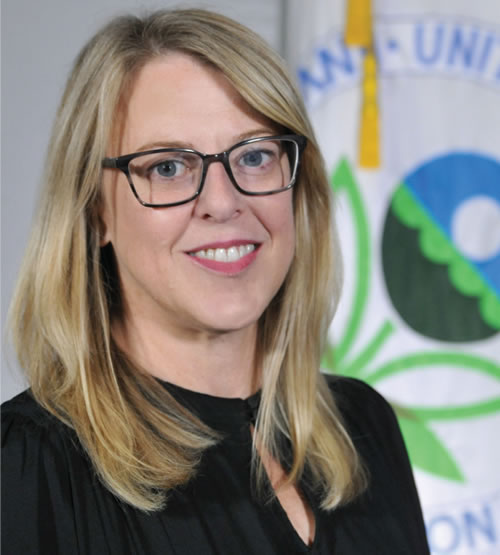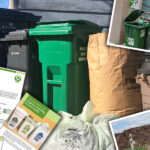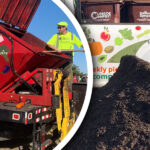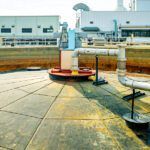BioCycle REFOR19 continues our in-depth coverage of a wide range of topics related to food recovery and food waste recycling.
BioCycle September/October 2019

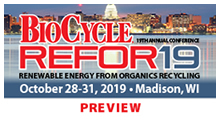 BioCycle’s 19th Annual Conference on Renewable Energy From Organics Recycling (BioCycle REFOR19) features presentations on topics ranging from public policies and project financing, to renewable natural gas and digestate and nutrient markets. As has been the case in recent years, many abstracts address food waste management, a perennial hot topic.
BioCycle’s 19th Annual Conference on Renewable Energy From Organics Recycling (BioCycle REFOR19) features presentations on topics ranging from public policies and project financing, to renewable natural gas and digestate and nutrient markets. As has been the case in recent years, many abstracts address food waste management, a perennial hot topic.
Each year, the breadth and depth of the abstracts reflect the continual learning about how to identify, source, collect, preprocess and anaerobically digest food waste feedstocks. Research continues to probe solutions to the challenges. This BioCycle REFOR19 Conference Preview article highlights presenter abstracts and offers a taste of what you will learn in Madison, Wisconsin, October 28-31.
Big Picture
U.S. EPA Excess Food Opportunities Map Version 2.0
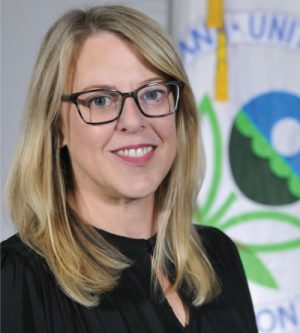
Julie Schilf, U.S. EPA Region 5
Julie Schilf, U.S. EPA Region 5
The U.S. EPA Excess Food Opportunities Map supports nationwide diversion of excess food from landfills. The interactive map identifies and displays facility-specific information about potential generators and recipients of excess food in the industrial, commercial and institutional sectors and also provides estimates of excess food by generator type. The map has been updated to Version 2.0 and now displays the locations of nearly 1.2 million potential excess food generators. Presentation walks through newly added map features, and will demonstrate the map’s usefulness in the ArcGIS web app. A real-world example shows how the many layers in the map can be applied to locate potential feedstock sources, identify potential locations for organics recycling sites, and explore other local opportunities. Data can be exported and used in customized maps.
Technology Solutions Across The Food Recovery Hierarchy
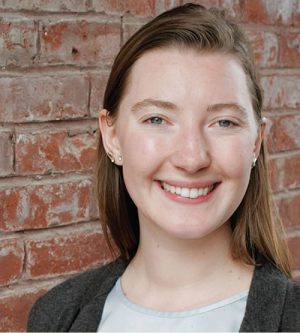
Coryanne Mansell, Center for EcoTechnology (CET)
Coryanne Mansell, Center for EcoTechnology (CET)
Success stories and examples of how technology has advanced food waste reduction across the EPA’s Food Recovery Hierarchy will be highlighted, starting with source reduction and how software tools such as Phood and LeanPath are enabling businesses and institutions to measure and prevent excess food at the source, while apps like Food for All help businesses attract customers to purchase excess food. Technology is also playing an important role in facilitating the connections and logistics necessary for food donation. Software platforms such as the MEANS database, Food Maven, and Spoiler Alert connect donating businesses with recipient organizations, while some food rescue organizations such as Philabundance and Food Connect have also developed partnerships to connect and feed more hungry people. CET will also discuss how the growth of depackaging technology is enabling food banks to clear more space and allow for new donations, while cameras and sensors help detect contamination and ensure organics loads are suitable to be diverted from disposal.
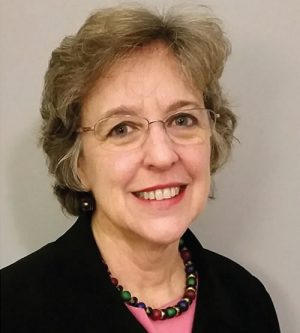
Carol Adaire Jones, Environmental Law Institute, Food Waste Initiative Co-Lead
Shifting WRRFS To A Circular Economy Business Model: It Takes An Innovation Ecosystem
Carol Adaire Jones, Environmental Law Institute, Food Waste Initiative Co-Lead
The wastewater sector’s “Utility of the Future” (UOTF) initiative envisions a transformation to a circular economy business model, shifting the sector mission from managing waste to managing critical resources — water, energy and nutrients. A culture of innovation is needed to accomplish this transformation, which is challenging in a sector that is adverse to risks that could compromise its charge to protect public health. To this end, the UOTF envisions a clean water “innovation ecosystem” that supports the sector pioneering this new business approach. Those involved in the wastewater innovation ecosystem include: technology developers, engineering and consulting firms, the public and private finance community, energy utilities, the solid waste sector, municipal, state and federal government, and clean water and solid waste professional organizations.
This talk focuses on wastewater resource recovery facility (WRRF) decision-making to adopt codigestion of food waste, a core component of the circular economy for the wastewater sector. With fewer than 1 in 10 WRRFs using AD to process treatments solids, and about 1 in 10 of those also codigesting high strength organic wastes, there appears to be significant untapped potential for codigestion. The literature has identified various financial, operational, regulatory, stakeholder/political, and organizational risks and impediments to adoption of codigestion and energy generation projects, which are outside core wastewater treatment services. We identify specific actions that can be taken to solve the impediments and promote innovation. A series of case study examples are used to illustrate solutions.
Building Support, Reducing Opposition For Organics Requirements
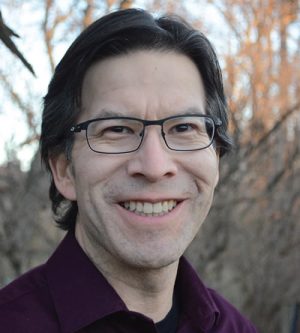
John Jaimez, Hennepin County, Minnesota
John Jaimez, Hennepin County, Minnesota
The Hennepin County Board of Commissioners approved revisions to the county’s recycling ordinance on November 27, 2018. The changes require businesses that generate large quantities of food waste to implement food waste recycling by January 1, 2020, and cities to offer organics recycling service to residents by January 1, 2022. Establishing organics recycling requirements began during development of the county’s 2018-2023 Solid Waste Management Master Plan (SWMMP). The multiple rounds of public engagement conducted during the course of two years were critical to gaining approval of the requirements.
The engagement process started with development of guiding principles and a draft framework for the requirements. Throughout 2017, feedback on these components was gathered from internal and external stakeholders. The findings were incorporated into the draft SWMMP, which the County Board approved at the end of 2017. In 2018, revisions to the county’s recycling ordinance were drafted. The revised language was widely distributed, and the next round of public engagement began. Input on the ordinance language was solicited from more than 16,000 stakeholders including city representatives, trade associations, waste haulers, property managers, businesses, and the broader community. At the end of 2018, the County Board approved revisions to the county’s recycling ordinance with very little opposition. Well-executed public engagements were the most important factor contributing to successful approval of the organics recycling requirements.
Sourcing, Collection
Food Scraps Collection Odyssey
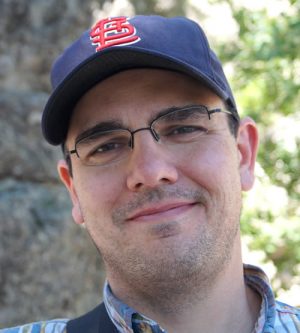
Bryan Johnson, City of Madison, Wisconsin
Bryan Johnson, City of Madison, Wisconsin
Starting in the late 2000s, the City of Madison began researching ways to divert food scraps from the landfill. In 2011, a pilot residential curbside collection program was launched, which lasted for seven years until the pilot ended due to contamination issues. But in August 2019, a new short-term trial of residential food scraps collection got underway. Also in 2019, the City of Madison received a grant from the U.S. EPA to study the financial feasibility of a regional food scraps anaerobic biodigester. This presentation will cover the trials and stumbles from years of trying to provide food scraps diversion services and how Madison hopes to use the lessons learned and the information from the EPA grant to finally provide food scraps recycling to the city.
Biomass Sourcing For Municipal Anaerobic Digestion
Mark Suchan, quasar energy group
Municipal anaerobic digesters typically have different drivers and success matrices than for-profit merchant anaerobic digesters. Most municipalities do not have the expertise, laboratory, operational, and sales experience necessary to successfully implement and manage ongoing biomass sourcing programs, thus creating demand for third party biomass suppliers. Navigating the approval process, developing contingency locations, personnel engagement, and maximizing value to drive revenue are all areas of focus for these biomass sources services.
Tools to be discussed are: 1) Biomass Decision Tree that helps create a robust approval process for all new materials to be put through the digester, and minimizes contamination and operational challenges; 2) Feedstock Calculator to create a value-based pricing model, understand expenses associated with each feedstock, and identify profit drivers, e.g., some tip fees need to be higher for more risk whereas others can be lower because of more energy production; and 3) Smartsheet/Operational Data to provide daily updates of all necessary parameters for the digester, and equipment and biological health tracking.
Food Waste Collection Best Practices
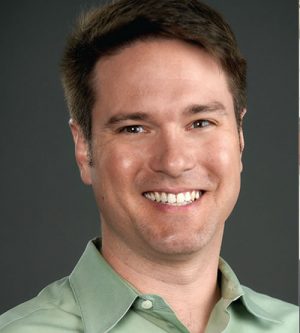
Ryan Cooper, Rubicon Global
Ryan Cooper, Rubicon Global
Food waste comes in many forms: recalls, expired products, rejected loads, damaged goods, and discontinued items. Case studies highlight best practices for food waste collection at multiple types of facilities — from grocery stores to restaurants, from distribution centers to break rooms. The unique organics recycling challenges these businesses face are as different as the businesses themselves. For example, how did a small-box retailer manage its expired milk using anaerobic digestion, a distribution center find a solution for its packaged food waste involving depackaging and AD, or a grocery chain develop a successful process for food waste collection? Lessons learned and how to apply these best practices to other generators will be discussed.
Preprocessing
Value Of Source Separated Food Waste In AD
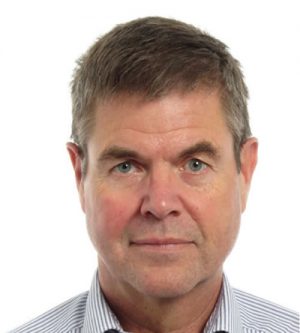
Lars Ravn Nielsen, Gemidan Ecogi A/S
Lars Ravn Nielsen, Gemidan Ecogi A/S
The Danish government has banned organic waste from landfills since 1997. Today, anaerobic digestion represents a unique opportunity for recycling the nutrients in source separated food waste to produce biogas and fertilizer. Concerns over impurities and pathogens, however, stall the uptake of source separated food waste in AD plants.
Gemidan Ecogi has developed a technology that separates the organic fractions of the source separated food waste. The system receives glass and metals, and achieves 95 percent organic recovery. The pulp is in high demand by biogas developers looking for a feedstock that has a fast reaction in the digester and produces a nutrient rich fertilizer for the farmers. Gemidan Ecogi will go through the drivers of diverting source separated food waste in Denmark and present test results from case studies.
Food Scrap Slurry Characteristics And Value
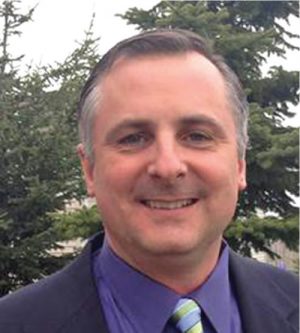
Casey Furlong, InSinkErator
Casey Furlong, InSinkErator
Research into the physical and biochemical methane potential characteristics of Emerson’s Grind2Energy™ food scrap slurry over the past several years has been useful in understanding the system’s operation and output. This presentation covers the slurry’s physical characteristics such as pH, viscosity and density and explores the weight to volume conversion calculations. It will explain how even short-term storage of the ground food posed challenges in collecting and analyzing representative samples while the preprocessing helps accelerate biogas production. Some rule of thumb metrics about what a quantity of food scraps will yield — including a comparison of the theoretical vs. laboratory biochemical methane potential and expected biosolids production documented by internal and third-party research — will be reviewed. A novel method for estimating food scrap generation quantities from grocery stores will also be described. Finally, using this data, calculations can be made to approximate Renewable Identification Numbers and Renewable Energy Certificates values for a given quantity of food scraps.
Case Studies
Digester Rescue: When Adding FOG And Other High Strength Wastewater Goes Wrong
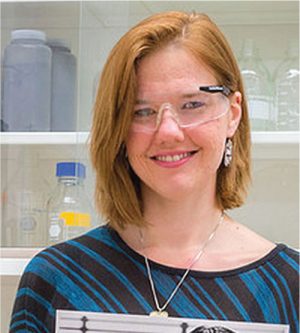
Jessica Linville-LeRoy, Mendota
Agri-Products
Jessica Linville-LeRoy, Mendota Agri-Products
Mendota Agri-Products is a used cooking oil rendering facility. In May 2013, the facility installed a 2.4 million gallon mixed covered lagoon digester to treat the process wastewater, which contains high concentrations of fats, oil, and grease (FOG). Additional high strength wastewater is brought in to increase biogas production. Originally the digester did not have a method for heating the system. Process wastewater was heated in the plant to keep the digester warm. This method did not work well in the winter, reducing biogas production. These factors resulted in overfeeding the digester, reducing the pH. Ammonia was added to adjust the pH, causing ammonia toxicity. This digester was prone to frequent upset and shutdowns. Approximately 3-feet of solid FOG had accumulated on the surface of the digester.
In July 2017, a boiler/heat exchange system was installed to maintain the digester’s temperature. In March 2018, the digester’s cover was taken off to remove FOG buildup, however the digester’s entire lining was ultimately replaced. The facility has been operating successfully since. This presentation focuses on the lessons learned through the digester rebuild process, increasing the facility’s process controls, and optimizing the high strength wastewater addition.
FCPC Renewable Generation Lessons Learned
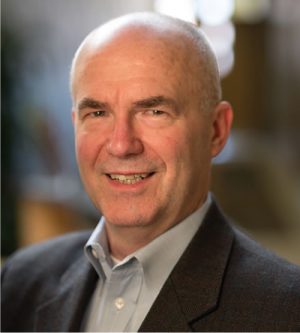
Charles Opferman, FCPC Renewable Generation
Charles Opferman, FCPC Renewable Generation and Sara M. Drescher, Forest County Potawatomi Community
The traditional values of the Forest County Potawatomi Community (FCPC) teach us to respect all living things, to take only what we need from mother earth, and to preserve the air, water, and soil for our children. Five years ago, FCPC placed a 2 MW cogeneration plant into service, powered with biogas created by anaerobic digestion. The digesters operate solely on liquid (pumpable) feedstock that comes from the adjacent Potawatomi Hotel and Casino (PHC) as well as by-products of local and regional food processors and biofuel production. Development of the biogas plant was mission driven, not as a response to regulatory or economic issues. The plant was awarded an ABC Project of the Year in 2015.
Challenges during project development included permitting, siting, timing, funding, ownership entity selection, project delivery approach, and technology. Through five years of operation, the FCPC has continued to address and adapt to ongoing challenges. These include regulatory, market, technology, and operational issues. The plant has undergone a series of modifications to adapt to the changing market demands, optimize technology, increase resiliency, and address unanticipated issues. As part of the Tribe’s educational mission, the facility’s operators will share insights gained and lessons learned in the continued evolution of this plant.
Midwest Regional Organics Facility: Concept to Construction
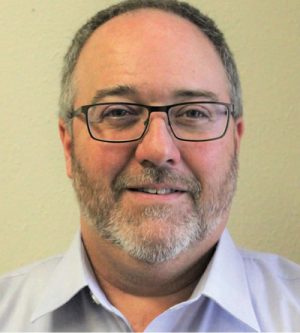
Jon Koch, City of Muscatine, Iowa
Jon Koch, City of Muscatine, Iowa
The City of Muscatine is constructing a regional packaged and loose organics collection and processing facility for municipal digester feedstock — one of the first of its kind in the Midwest. Utilizing existing infrastructure almost exclusively, Muscatine will receive trucks of packaged and loose food waste from regional industries for depackaging in an abandoned recycling center located at the City transfer station. Depackaging will be done by a Scott T42 Turbo separator by direct feed and from a new tip floor. The City will also receive grocery and school waste from local and surrounding communities. Anticipated top volume of 90 tons/day is to be processed and trucked down the street to the Water & Resource Recovery Facility for dosing to anaerobic digesters.
Existing municipal digesters and new construction of a modified agricultural digester will be utilized on site. Liquid commercial and industrial waste will be mixed with food waste and is anticipated to be 20,000 to 30,000 gallons daily. The presentation will give project development history, life-cycle and cost analyses, feedstock sourcing, biosolids handling planning, D3-D5 RIN gas separation concept, work flow and receiving analysis, community food waste movement called MARRVE (Muscatine Area Resource Recovery for Vehicles and Energy) and biogas pilot study results for final gas utilization. Project completion is anticipated by December 2019.
Food Waste Codigestion At WWRF: Goleta Sanitary District Pilot
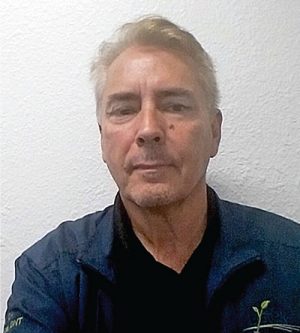
Jim Dunbar, Lystek
Jim Dunbar, Lystek
This presentation will discuss initial results of Lystek’s codigestion pilot project at the Goleta Sanitary District (GSD)’s Water Resource Recovery Facility (WRRF) in Goleta, California. The project was awarded a US$1.5 million grant from the California Energy Commission (CEC) to deploy an environmentally and economically sustainable organics-to-energy system. Source separated organics (SSO) from the University of California Santa Barbara (UCSB) are preprocessed and codigested with biosolids from GSD in mobile skid-mounted demonstration units. The SSO, which consist of pre and postconsumer food waste from the campus dining commons, are depackaged by a Smicon hammermill system that yields about 15 to 30 percent solids and less than 1 percent contamination by weight.
Two identical 8-cubic meter mesophilic anaerobic digesters are available; one serves as the control and the other is used for testing different codigestion ratio of biosolids and food waste, as well as different configuration and refeeding ratios of thermal hydrolysis product. Lystek’s patented thermal hydrolysis reactor increases biogas yield (predigestion step or refeeding lysed material into digesters) and converts the digestate into a nutrient-rich liquid biofertilizer.
Research
Accomplishments And Next Steps In Codigestion Research
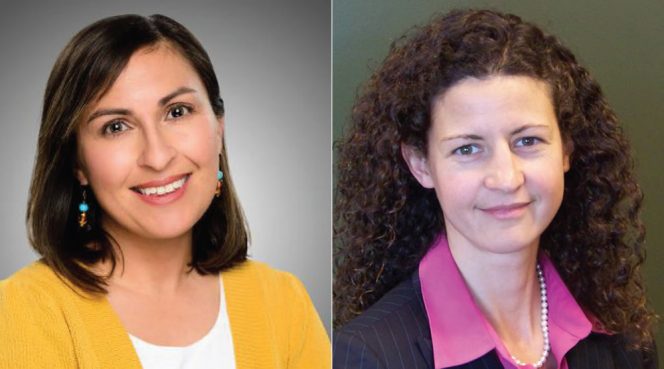
Stephanie Fevig, Water Research Foundation and Dr. Tanja Rauch-Williams, Carollo
Stephanie Fevig, Water Research Foundation and Dr. Tanja Rauch-Williams, Carollo
The Water Research Foundation (WRF) is a nonprofit research organization that funds water-sector focused research. In 2016, WRF established the Source Separated Organics Pre-Treatment and Management Strategies research focus area. The overarching goal of this research area is to provide wastewater facilities with the guidance, tools, and best practices to develop and manage a source separated organics codigestion program. The first four projects in this research program are completed or underway and include a framework of best practices for co-digestion, developing a business case for food waste co-digestion, characterization and contamination of source separated organic feedstocks, and evaluating existing pretreatment technologies (RFP out in 2019).
In addition to this focused program, WRF has funded numerous research projects in the area of codigestion. Research to date has investigated relevant regulatory, logistical, administrative, operational and design aspects of co-digestion systems and assessed various codigestion case studies in and outside of the U.S. in detail. This presentation will showcase key highlights from the research conducted to date, what to look forward to in the future, and finally how interested parties can get involved in research.
Acid Phase Digestion As Pretreatment To Enhance Codigestion Of SSO And Municipal Biosolids
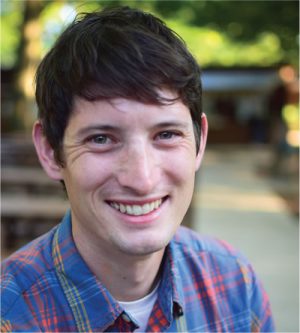
Matt Seib, Madison (WI) Metropolitan Sewerage District
Matt Seib, Madison (WI) Metropolitan Sewerage District
A study led by the Madison Metropolitan Sewerage District investigated the benefits and impacts of codigesting food waste (FW) and the organic fraction of municipal solid waste (OFMSW) with sewage sludges in lab-scale municipal digesters. The aim of this study was to assess if acid phase digestion could be used as a conditioning step to improve volatile solids (VS) destruction and methane yield when codigesting municipal sewage sludges with source separated organics (SSO). The study also sought to understand the sidestream impacts to wastewater treatment plants that may accept these wastes in terms of additional nutrient and biosolids management needs and resource recovery opportunities.
Overall, use of acid phase digestion ahead of methane phase digestion when codigesting SSO resulted in slightly greater VS destruction and methane yield compared to codigesting SSO without an acid phase step. These results demonstrate that acid phase digestion can help improve the conversion of complex VS to methane and is a valid process to generate further value from digestion of SSO sources such as food waste or OFMSW.
Photoionization Of Food Waste Process Odors: Demonstration Project
Mike Muffels, GHD
GHD was retained by the City of Toronto (Ontario) to assess the performance of photoionization as a potential odor treatment option for use at a residential food waste anaerobic digestion facility. A demonstration-scale Neutralox photoionization unit was installed and operated over July and August 2016 at Toronto’s Disco Road Organics Processing Facility (as the Dufferin facility was shutdown for renovations). The demonstration unit is 0.6 x 0.7 x 3.25 m (2.0 x 2.3 x 10.7 ft) and is able to treat roughly 200 to 300 m3/hr (60–120 cfm).
The demonstration unit was set up on two air streams representing a highly concentrated process air stream and a blended process and building air stream. Odor levels in the untreated air exceeded 200,000 odor units (ou) in some cases. Analysis was performed on samples collected at the photoionization unit inlet and outlet ducts on four separate days, for the following contaminants and contaminant groups: odor; hydrogen sulphide (H2S) and reduced sulfur compounds (RSCs); ammonia (NH3); terpene compounds: ketone compounds; carboxylic acids; and volatile organic compounds (VOCs).
Overall, the photoionization unit demonstrated excellent odor unit reduction (>99%) on a process airflow stream anticipated to be similar to that expected at the Dufferin facility. Even under conditions of elevated moisture and reduced residence contact time, the equipment still had excellent odor reduction capacity. A detailed capital and operating cost estimate for a photoionization will also be presented.
Modeling Impacts Of Food Wastes On Municipal WWTPs
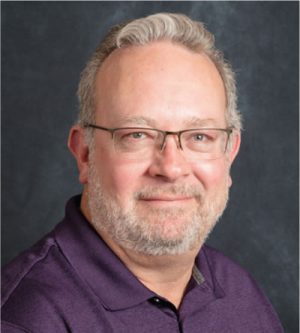
Michael Keleman, InSinkErator
Michael Keleman, InSinkErator
In 2013, researchers Harold Leverenz and George Tchobanoglous modeled the impacts of food waste disposers on three types of treatment plants with anaerobic digestion and concluded there was a net energy gain and a potential reduction in nutrients discharged in plant effluent where nutrient removal schemes were utilized. A more comprehensive analysis was initiated and completed in 2018 at Western University in London, Ontario by George Nakhla, who looked at 142 different scenarios to better understand the net energy and nutrient removal impacts of food waste processed in residential disposers. The modeling included conventional activated sludge plants, those using the Modified Ludzack Ettinger and Bardenpho processes, and plants using the A2O method of nutrient removal.
The results show that plants utilizing AD yield a net energy gain. More significant, instead of food waste increasing nutrients discharged in plant effluent, the modeling confirms food waste decreases nitrogen and phosphorus where plants utilize specific nutrient removal schemes. Even though there is a minimal increase in energy demand for aeration (10%-20%) and a slight increase in biosolids production (~10%), because of the increased production of biogas (19%-38%) and credit for carbon necessary for denitrification, Western University found that overall net costs for treatment are lower by as much as 70 percent.


